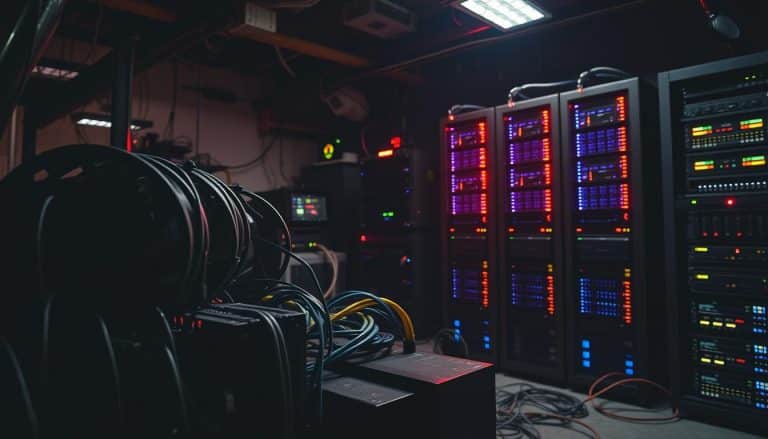The Dark Side of Blockchain: Unspoken Risks Revealed
Blockchain technology is known for bringing innovation to many areas, but it also comes with certain risks that aren’t often discussed.
One major issue is its potential to increase ransomware attacks due to the anonymity and decentralized nature of cryptocurrencies. This makes it difficult for authorities to track illegal transactions, posing a significant challenge to cybersecurity efforts.
Another concern is the environmental impact of blockchain, particularly regarding the energy consumption of processes like mining.
These activities require substantial computational power, leading to increased carbon emissions and contributing to global environmental challenges. Moreover, legal and regulatory challenges can arise as governments struggle to create relevant policies for this evolving technology.
Economic risks also loom large, as blockchain can disrupt traditional industries and jobs. The technology’s rapid evolution might cause uncertainty among businesses trying to adapt.
By diving deep into these risks, you can better understand the hidden challenges blockchain presents, preparing you for a more informed journey into this complex field.
Key Takeaways
- Blockchain can increase ransomware risks.
- It has a significant environmental impact.
- Legal and economic challenges are rising.
Understanding Blockchain Technology
Blockchain technology is a complex but impactful innovation in the digital world. In this section, you will learn about its core principles and how the public often misunderstands it.
Fundamentals of Blockchain
At its core, blockchain is a decentralized and immutable digital ledger. This means data recorded on it cannot be changed or deleted, ensuring a high level of security.
The technology operates in a distributed network where every participant has access to a copy of the entire blockchain. This makes unilateral control nearly impossible.
Blocks in a blockchain contain a list of transactions. They are linked together using cryptography. Once a block is full, it is sealed and added to the previous block, forming a continuous chain. This structure is key to the platform’s transparency.
Smart contracts are another vital aspect. These are self-executing contracts with terms directly written in code. They automate processes and reduce the need for intermediaries, which can save time and cost.
Public Perceptions and Misconceptions
Many people see blockchain only through the lens of cryptocurrencies, but its applications go beyond that. It holds potential for sectors like finance, healthcare, and supply chain management.
A common misconception is that blockchain technology is completely private. In reality, while some types, like private blockchains, offer more privacy, public blockchains are transparent and transactions can be publicly viewed.
People often think blockchain is completely secure. While it is more secure than many systems, it’s not invulnerable. The risk of ransomware attacks and other security threats still exists, especially where skilled hackers are involved.
Understanding these perceptions and misconceptions can provide you with a more comprehensive view of blockchain technology and its potential uses.
Security Vulnerabilities
Blockchain technology, while secure in some ways, has its own set of security vulnerabilities that can be exploited. These issues include the potential for 51% attacks, flaws in smart contracts, and risks associated with exchange platforms.
51% Attacks
A 51% attack occurs when a single entity gains control of more than 50% of a blockchain network’s mining power. This control allows them to reverse transactions and block others from happening.
This is especially concerning for smaller networks. It’s less likely on large networks like Bitcoin, but not impossible. Such attacks can undermine trust in the network and lead to significant financial losses. Understanding this risk can help in making informed decisions when engaging in blockchain activities or investments.
Smart Contract Flaws
Smart contracts are self-executing contracts with terms directly written into code. Despite their benefits, they can have vulnerabilities.
Bugs and logic errors in smart contracts can be exploited, leading to financial losses or unauthorized transactions. One famous incident is the DAO hack, where attackers exploited a flaw and stole about $50 million.
It’s crucial to audit smart contracts thoroughly before deployment to minimize these risks. Regular updates and security checks can also help in mitigating potential flaws.
Exchange Platform Risks
Exchange platforms handle a high volume of cryptocurrency trades and can be attractive targets for hackers.
Security vulnerabilities in exchange software can lead to major breaches. In the past, platforms like Mt. Gox have faced significant attacks, resulting in substantial financial losses for users.
To protect your assets, choose exchanges with strong security measures, such as two-factor authentication, and keep most funds in secure wallets. Regularly updating security settings and being aware of phishing scams can also help in safeguarding your assets.
Legal and Regulatory Challenges
Blockchain technology poses significant legal and regulatory challenges across the globe. Key issues include varying regulations from country to country and difficulties in enforcement and compliance. These challenges create complexities in the adoption and utilization of blockchain systems.
Global Regulation Variance
Different countries have their own approaches to blockchain regulation. Some nations have embraced the technology with minimal restrictions, while others impose strict regulatory frameworks. This variation can lead to confusion and inconsistency for businesses operating internationally.
In countries like Switzerland and Singapore, blockchain is often seen as an innovation driver, with relatively friendly laws. However, in countries such as China and India, regulations are stricter, limiting blockchain applications.
Navigating this diverse regulatory landscape requires careful planning and understanding of each jurisdiction’s requirements and restrictions.
Compliance and Enforcement Difficulties
Compliance becomes complex when blockchain’s decentralized nature and anonymity are considered. This technology often challenges traditional legal systems, which are not designed to handle decentralized networks.
This can lead to difficulties in tracking transactions and ensuring legal compliance.
Enforcement is another major hurdle. Legal systems must determine responsibility and liability, which becomes challenging given the anonymous nature of blockchain transactions. Smart contracts bring additional challenges, as they are self-executing and difficult to amend.
Addressing these issues necessitates innovation in legal frameworks to ensure that blockchain technology can be effectively managed and regulated.
Environmental Concerns
Blockchain technology, particularly its proof-of-work mechanism, has significant environmental impacts. This section covers the energy use in mining processes and the challenges in creating sustainable blockchain networks.
Energy Consumption of Mining
The mining process in blockchain technology uses a lot of energy. Cryptocurrencies like Bitcoin need miners to solve complex puzzles. This activity requires powerful computers running constantly.
These computers use electricity similar to that of small countries. As blockchain grows, the need for more energy increases, raising concerns about its sustainability.
Some reports highlight that Bitcoin alone might use as much energy as entire nations. This high energy consumption makes people wonder if the benefits of blockchain outweigh the environmental costs. It’s crucial to address these issues to ensure the technology doesn’t harm the planet.
Sustainability of Blockchain Operations
Sustainability in blockchain is a growing concern given its energy needs. Many are exploring alternatives like proof-of-stake to reduce power consumption.
This alternative lessens the necessity for heavy computational work, lowering environmental impact.
Companies are also looking at renewable energy sources to power blockchain operations. Some blockchain networks actively invest in green technology to offset their carbon footprint.
By focusing on energy-efficient practices, blockchain can be both innovative and environmentally friendly.
You might find possibilities for sustainable blockchain technologies that benefit both businesses and the environment when the industry works towards greener solutions.
Economic Risks
Blockchain technology has significant potential, but it also presents notable economic risks. Market volatility and speculative behavior can lead to rapid price changes, while the possibility of an asset bubble may threaten financial stability. Understanding these risks can help you make more informed decisions in this evolving landscape.
Market Volatility and Speculation
Cryptocurrencies and blockchain-related assets are known for their volatile nature. Prices can swing dramatically within short periods due to factors like market sentiment, regulatory news, or technological changes.
This unpredictability can be influenced by speculative activities, where investors bet on price movements without considering underlying asset value or long-term fundamentals.
You might see rapid gains or steep losses, making it a risky area for inexperienced investors. Speculative trading can exacerbate this, as large movements in buying or selling may lead to sudden price jumps or drops. This market volatility means you need to stay informed and exercise caution when investing.
Asset Bubble Concerns
The rapid increase in the value of blockchain assets has led to worries about potential asset bubbles. A bubble occurs when asset prices rise significantly over their intrinsic value driven by exaggerated expectations about future growth.
Once investors start to sell, realizing that values don’t match prospects, prices can crash.
This boom-and-bust cycle can lead to significant financial losses for those buying at inflated prices.
To protect against such risks, scrutinize asset values, assess market conditions, and consider the sustainability of growth forecasts. Be mindful of the economic foundations supporting asset prices to avoid investing in over-valued markets.
Impact on Traditional Industries
Blockchain technology is reshaping traditional industries. It challenges established business models and disrupts conventional processes. This section explores how blockchain disrupts existing businesses and interferes with the banking sector.
Disruption of Conventional Businesses
Blockchain alters traditional businesses by introducing new ways to record and verify transactions. Industries like supply chain management benefit from increased transparency as every transaction is recorded on a distributed ledger. This transparency reduces fraud and errors since all parties have access to the same information.
Blockchain also impacts service industries, like real estate, by simplifying complex processes. Property transactions become faster and cheaper by cutting out intermediaries and replacing paper trails with digital records. This digital transformation encourages businesses to innovate and adapt to stay competitive.
Some businesses may struggle due to a lack of blockchain adaptation, highlighting the tension between innovation and tradition.
Interference with the Banking Sector
The banking sector encounters significant challenges from blockchain technology. Traditional bank processes are often slow and expensive due to multiple intermediaries.
Blockchain offers streamlined transactions, reducing those intermediaries and enabling faster, cheaper transfers.
Banks face competition from cryptocurrencies, which threaten to replace conventional currencies. People can transfer money globally without costly fees.
Banks must adapt by incorporating blockchain to remain relevant. Some banks explore digital currencies or blockchain-based services to fit evolving customer demands. Regulatory concerns also arise as decentralized systems challenge existing financial laws, posing questions about security and legality. Despite these challenges, blockchain can bring innovation if banks learn to embrace its potential benefits.
Blockchain Anonymity Issues
Blockchain’s promise of anonymity is both a strength and a challenge. Understanding the distinction between pseudonymity and anonymity, as well as the implications for illegal activities, is essential when considering this technology.
Pseudonymity vs Anonymity
In blockchain, transactions aren’t truly anonymous. They’re pseudonymous. This means that instead of your identity, a unique string of characters represents you.
While this provides some privacy, it’s different from complete anonymity.
With enough resources, entities might trace a pseudonymous address back to an individual. For example, connecting patterns of transactions with external data sources can sometimes reveal personal identities.
Contrast with Complete Anonymity: While systems like cash transactions are genuinely anonymous, blockchain records are public and permanent. This pseudonymity might protect your identity at a surface level, but deeper analysis can sometimes uncover more than you’re comfortable with.
Implications for Illegal Activities
Blockchain’s pseudonymous nature has caught the interest of those wishing to conduct illegal activities anonymously. The use of cryptocurrencies in activities like money laundering and ransomware attacks is an example.
These exploits take advantage of blockchain’s immutable nature and decentralization. Once a transaction is confirmed, it cannot be undone or altered, which safeguards criminals in keeping their actions hidden.
The public ledger records transactions without directly linking them to identities, enabling certain clandestine operations.
Efforts are being made to improve tracking and transparency without compromising privacy. Regulations and advanced monitoring tools are part of this push, helping ensure that blockchain’s potential benefits aren’t overshadowed by these risks.
Scalability and Performance
Blockchain technology is often touted for its security and transparency, but its scalability and performance issues can’t be ignored. These challenges are most apparent in transaction speed limitations and the growing pains of expanding blockchain networks.
Transaction Speed Limitations
Blockchain networks measure performance through transactions per second (TPS). Many blockchains struggle to handle a high volume of transactions quickly.
The decentralized nature means that every transaction must be verified by multiple nodes, causing bottlenecks.
You may find that a simple solution like increasing block size does allow more transactions per block. However, this can lead to issues with decentralization, as it requires more computing power and space.
Newer methods, such as sharding, try to divide network data more efficiently. Sharding can significantly enhance throughput by splitting the network data into smaller chunks to be processed in parallel.
Growing Pains of Blockchain Networks
As blockchain networks expand, they face challenges in handling larger loads effectively. The more users and transactions that a network has, the more strain it experiences. This can lead to slower transaction times and increased likelihood of errors.
Moreover, the initial infrastructure might not account for rapid growth, making timely upgrades essential. Protocols are needed to ensure that increases in network activity do not degrade performance.
Solutions are being explored, including interchain transfers that allow multiple blockchains to interact seamlessly.
Overdependence and Centralization Concerns
Blockchain technology is often seen as a solution for decentralization. However, sometimes there can be too much dependence on certain systems, leading to centralization issues. This may create risks that are not immediately apparent but can have a significant impact on the security and effectiveness of blockchain networks.
Power Imbalance Risks
One major concern is the risk of power imbalances. When a few entities control a large portion of the blockchain’s resources, it can lead to decision-making that favors those with more control.
This is evident in some blockchains where certain validators or miners hold significant sway due to their large contributions. Such imbalances can skew governance decisions and impact the network’s fairness and reliability.
Additionally, these power holders may have the ability to make changes that benefit themselves, compromising the network’s overall integrity. They might manipulate transaction priorities or alter transaction fees to suit their agendas.
This concentration of power can erode trust among participants and reduce the effectiveness of the blockchain’s purported decentralization.
Centralized Points of Failure
Blockchain networks, while decentralized by design, can still suffer from centralized points of failure. These occur when critical processes or infrastructure are controlled by a limited number of entities.
For instance, if a popular cryptocurrency exchange controls a significant portion of the network transactions, its compromise could lead to massive disruptions or data breaches.
Examples include centralized custodial services which manage users’ assets. If these services are hacked, users could lose their possessions.
Furthermore, centralized governance mechanisms can become a single point that adversaries might target.
Hence, ensuring that networks are truly decentralized and have distributed control is essential in mitigating these risks. This approach protects your investments and preserves the security promised by blockchain technology.
Tech Dependency and Obsolescence
Relying on blockchain technology for various operations involves challenges. As blockchain evolves, adapting becomes crucial. Integrating it with existing systems presents its own set of hurdles.
Blockchain Evolution and Adaptability
As blockchain technology evolves, you face the issue of technology becoming outdated. Newer blockchain versions or entirely different technologies can quickly overshadow current systems.
This may force you to upgrade frequently, which can be both costly and time-consuming. Staying updated requires constant learning and adaptation, ensuring that your systems are compatible with the latest advancements.
Moreover, blockchain protocols can change. Each change necessitates a thorough evaluation of its impact on existing operations.
In highly regulated industries, adapting to these updates may involve additional compliance adjustments. All these factors contribute to the complex landscape you must navigate to benefit fully from blockchain.
Legacy System Integration
Integrating blockchain with legacy systems is often challenging, demanding extensive resources and time.
Legacy systems were not designed with blockchain in mind, which can lead to compatibility issues. You may need to employ middleware solutions or redesign certain parts of your infrastructure to achieve seamless integration.
Data transfer from old systems to blockchain also involves careful planning. Ensuring that this data remains accurate and intact is critical.
Additionally, training your team to work with integrated systems can be resource-intensive, requiring new skill sets and understanding.
These integration challenges can significantly impact operations, necessitating a well-thought-out strategy for successful implementation.
Frequently Asked Questions
Blockchain presents unique advantages, yet it also brings concerns about security, regulation, privacy, and inequality. Understanding these issues is essential as blockchain continues to grow in influence and application.
What are the potential risks associated with blockchain technology?
Blockchain technology can face security vulnerabilities when implemented poorly. Unauthorized access and smart contract bugs are common concerns.
The decentralized nature means that once data is recorded, it cannot be changed easily, making it critical to ensure initial accuracy.
How can blockchain be exploited for illicit activities?
Due to its anonymity and untraceable nature, blockchain can be used for illegal activities. Criminals might use it for money laundering or ransomware attacks.
The decentralized nature makes tracking and controlling these activities challenging, resulting in potential misuse for crimes.
What are the environmental impacts of blockchain?
Blockchain, especially cryptocurrencies, can consume significant amounts of energy. The process known as “mining” requires substantial computational power, thereby impacting the environment through increased carbon emissions.
These effects raise concerns about sustainability.
How does blockchain technology challenge regulatory frameworks?
Blockchain operates beyond borders, complicating regulatory oversight. Jurisdictions may find it difficult to enforce laws on decentralized networks.
This lack of centralized control can lead to clashes with existing regulation systems worldwide, challenging established norms.
What are the privacy concerns surrounding blockchain?
Blockchain ledgers are public, potentially exposing personal transaction details. While identities are protected through encryption, transaction patterns could still be analyzed.
Personal and financial data might become accessible, raising concerns about privacy and data security.
How can blockchain contribute to economic inequality?
Blockchain might widen economic disparities. Its benefits often favor those with access to technology and resources, potentially leaving out those without them.
This digital divide can exacerbate existing inequalities, making wealth distribution more uneven globally.








 Bitcoin
Bitcoin  Ethereum
Ethereum  Tether
Tether  XRP
XRP  USDC
USDC  TRON
TRON  Lido Staked Ether
Lido Staked Ether  Dogecoin
Dogecoin  Figure Heloc
Figure Heloc  Cardano
Cardano  WhiteBIT Coin
WhiteBIT Coin  Wrapped stETH
Wrapped stETH  Bitcoin Cash
Bitcoin Cash  Wrapped Bitcoin
Wrapped Bitcoin  USDS
USDS  Wrapped eETH
Wrapped eETH  Binance Bridged USDT (BNB Smart Chain)
Binance Bridged USDT (BNB Smart Chain)  Chainlink
Chainlink  Monero
Monero  WETH
WETH  LEO Token
LEO Token  Zcash
Zcash  Stellar
Stellar  Hyperliquid
Hyperliquid  Coinbase Wrapped BTC
Coinbase Wrapped BTC  Ethena USDe
Ethena USDe  Litecoin
Litecoin  Sui
Sui  Avalanche
Avalanche  Hedera
Hedera  sUSDS
sUSDS  USDT0
USDT0  Shiba Inu
Shiba Inu  Dai
Dai  Uniswap
Uniswap  PayPal USD
PayPal USD  Mantle
Mantle  Cronos
Cronos  World Liberty Financial
World Liberty Financial  Toncoin
Toncoin  Ethena Staked USDe
Ethena Staked USDe  Canton
Canton  Polkadot
Polkadot  USD1
USD1  Rain
Rain  MemeCore
MemeCore  Aave
Aave  Bitget Token
Bitget Token